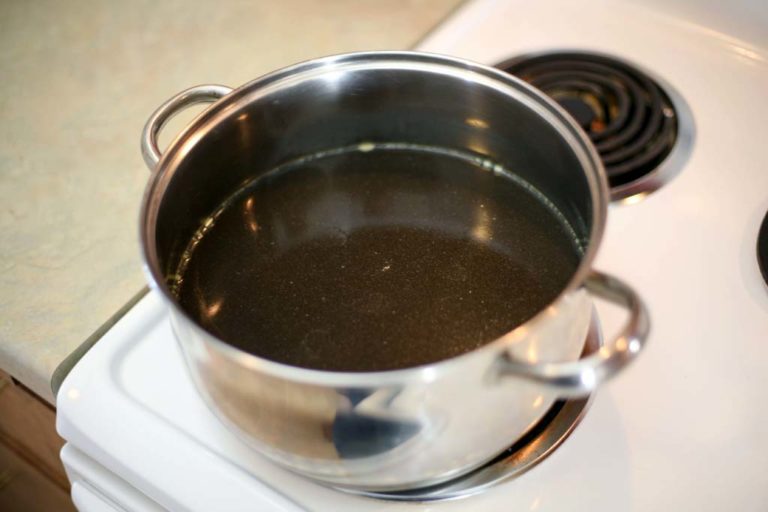
Chef's notes:
This basic beef stock recipe (beef bones, onion, carrot, celery, thyme, bay leaves, black peppercorns, and water) is made by simmering the roasted beef bones with the roasted vegetables, herbs, and spices for 10‒12 hours. Of course, there are a lot of variations. But for the purpose of teaching you how to make beef stock, we will use this simple and easy-to-learn recipe. One challenge in making stock is making it a clear stock. For chefs it can actually be one of the biggest challenges, especially when cooking classical French cuisine. Luckily, for most home applications, clarity of stock is irrelevant. We just want to make sure we filter it as best we can.
Ingredients
- 10 pounds beef bones
- 2‒3 Tbsp flour
- 6 onions
- 8 carrots
- 8 celery ribs
- 8 sprigs thyme
- 4 bay leaves
- 2 Tbsp whole black peppercorns
- Water, enough to cover
Beef Stock Recipe: Beef Bones Roasted and then Simmered with Mirepoix and Herbs to Make a Basic Dark Beef Stock
- Buy and roast some beef bones. It can sometimes be difficult to track down beef bones. Try calling around first and ask the butchers specifically for bones to make stock. Then put the bones in a large roasting pan and dust with flour. Then roast them in a 400 degree F oven for an hour. Check them once in a while and flip them around. You want them to get dark, but not black.
- Wash, trim, and roast some vegetables. For these 10 pounds of bones, I am using 6 medium-sized onions, 8 carrots, and 8 ribs of celery. The ratio for this mirepoix is 50% onion, 25% carrot, and 25% celery. Peel the carrot and trim the celery and onion. Cut the vegetables into large chunks, and roast them in an oiled roasting pan for about 30 minutes.
- Put everything together in a large stockpot. The stock pot I am using is a five gallon or 20 quart stock pot that I picked up at a brewery supply store. Put everything into the stock pot except for the fat from the roasting pans. Then toss in the thyme, bay leaves, and peppercorns. Add enough cool water to cover the bones and vegetables by at least an inch or perhaps more, depending on how tightly packed everything is.
- Simmer the beef bones and vegetables uncovered for 10‒12 hours. The reason we simmer the beef stock for so long is so we get everything we can out of the bones. You want the beef stock to simmer, but not boil. We never want our stock to boil, ever! Also you will want to skim the foam and fat off the top as often as possible. As the stock simmers it will be reducing, in 10‒12 hours it will be reduced by half or more.
- Skim and strain the beef stock. Skim the beef stock right up until the end. Once the stock has simmered for 10‒12 hours remove and dispose of the bones. Then pour the rest through a fine mesh strainer into another pot. Then to remove even more stuff, pass the whole thing again through a cheesecloth. Do this as many times as you like to remove the little floaties. Then taste the stock. If it’s a little weak, you can always reduce it further.
Tips & Tricks
- You can also use beef shank, neck, or other boney meat to make beef stock, but it changes the flavor profile a little. Some say that it’s better, but that just depends on what you want to do with it. One of the reasons we use bones to make stock is to get the gelatin, which makes great sauces. The meat will not add any of that, but it will make the stock/broth meatier.
- Carrot, celery, and onion when combined are known collectively as “mirepoix.”
- You would think that bones would be one thing that butcher shops have a surplus of. You know, from all the butchering. But sadly, few butcher shops actually butcher in-house these days. Instead, they have their products shipped in pre-packaged.
- Bullion cubes are disgusting, and even cartons or cans of stock can’t hold a candle to the homemade stuff.
- Smear the bones with tomato paste before dusting them with flour and roasting them to get even more flavor and darkness out of them.
